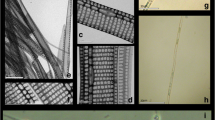Abstract
Isolates of Nocardia cummidelens, Nocard ia fluminea, Streptomyces albidoflavus, and Streptomyces luridiscabiei attributed as the cause of “earthy-musty” off-flavor in rainbow trout (Oncorhynchus mykiss) raised in recirculating aquaculture systems (RAS) were evaluated for the effect of temperature (10–30 °C) on biomass, geosmin, and 2-methylisoborneol (MIB) production and cellular activity. Cultures of these isolates were monitored over 7 days by measuring culture dry weight, geosmin, and MIB production using solid-phase microextraction-gas chromatography-mass spectrometry (SPME–GC–MS), and ATP production via a luminometer. Compared to the other isolates, S. luridiscabiei had significantly (P < 0.05) higher biomass (8.17 ± 0.35 mg/mL) at 15 °C (water temperature in the RAS) after 7 days incubation. In addition, S. luridiscabiei produced significantly (P < 0.05) higher geosmin (69,976 ± 15,733 ng/L) at 15 °C. At 25 °C and 30 °C, S. albidoflavus produced significantly (P < 0.05) higher geosmin (182,074 ± 60,272 ng/L and 399,991 ± 102,262 ng/L, respectively). All isolates produced MIB at 15 °C, but S. luridiscabiei produced significantly (P < 0.05) higher MIB (97,143 ± 28,972 ng/L) and ATP after 7 days. Therefore, S. luridiscabiei appears to be a likely contributor of geosmin and MIB in the RAS.






Similar content being viewed by others
References
Blevins WT, Schrader KK, Saadoun I (1995) Comparative physiology of geosmin production by Streptomyces halstedii and Anabaena sp. Wat Sci Technol 31(11):127–133
Burr GS, Wolters WR, Schrader KK, Summerfelt ST (2012) Impact of depuration of earthy-musty off-flavors on fillet quality of Atlantic salmon, Salmo salar, cultured in a recirculating system. Aquacult Eng 50:28–36
Guttman L, van Rijn J (2008) Identification of conditions underlying production of geosmin and 2-methylisoborneol in a recirculating system. Aquaculture 279:85–91
Lloyd SW, Lea JM, Zimba PV, Grimm CC (1998) Rapid analysis of geosmin and 2-methylisoborneol in water using solid phase micro extraction procedures. Water Res 32:2140–2146
Schrader KK, Blevins WT (1999) Effects of selected environmental conditions on biomass and geosmin production by Streptomyces halstedii. J Microbiol 37:159–167
Schrader KK, Blevins WT (2001) Effects of carbon source, phosphorus concentration, and several micronutrients on biomass and geosmin production by Streptomyces halstedii. J Ind Microbiol Biotechnol 26:241–247
Schrader KK, Summerfelt ST (2010) Distribution of off-flavor compounds and isolation of geosmin-producing bacteria in a series of water recirculating systems for rainbow trout culture. N Am J Aquacult 72:1–9
Schrader KK, Nanayakkara NPD, Tucker CS, Rimando AM, Ganzera M, Schaneberg BT (2003) Novel derivatives of 9,10-anthraquinone are selective algicides against the musty-odor cyanobacterium Oscillatoria perornata. Appl Environ Microbiol 69:5319–5327
Tucker CS (2000) Off-flavor problems in aquaculture. Rev Fish Sci 8:45–88
Uwins HK (2011) Triggers for taste and odour events: a study of microbial production of geosmin and 2-methylisoborneol. Doctoral dissertation. Griffith University, Nathan
Weete JD, Blevins WT, Wilt GR, Durham D (1977) Chemical, biological, and environmental factors responsible for the earthy odor in the Auburn city water supply. In: Bulletin of the Alabama Agricultural Experiment Station 490, Auburn University, Auburn, AL, p 46
Acknowledgments
The technical assistance of Michael McCain is greatly appreciated.
Author information
Authors and Affiliations
Corresponding author
Rights and permissions
About this article
Cite this article
Schrader, K.K., Harries, M.D. & Page, P.N. Temperature effects on biomass, geosmin, and 2-methylisoborneol production and cellular activity by Nocardia spp. and Streptomyces spp. isolated from rainbow trout recirculating aquaculture systems. J Ind Microbiol Biotechnol 42, 759–767 (2015). https://doi.org/10.1007/s10295-015-1600-2
Received:
Accepted:
Published:
Issue Date:
DOI: https://doi.org/10.1007/s10295-015-1600-2




